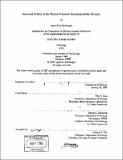| dc.contributor.advisor | Peter S. Kim and Pamela J. Bjorkman. | en_US |
| dc.contributor.author | Hamburger, Agnes Eva, 1976- | en_US |
| dc.contributor.other | Massachusetts Institute of Technology. Dept. of Biology. | en_US |
| dc.date.accessioned | 2008-02-28T16:04:42Z | |
| dc.date.available | 2008-02-28T16:04:42Z | |
| dc.date.copyright | 2005 | en_US |
| dc.date.issued | 2005 | en_US |
| dc.identifier.uri | http://dspace.mit.edu/handle/1721.1/28935 | en_US |
| dc.identifier.uri | http://hdl.handle.net/1721.1/28935 | |
| dc.description | Thesis (Ph. D.)--Massachusetts Institute of Technology, Dept. of Biology, 2005. | en_US |
| dc.description | Includes bibliographical references. | en_US |
| dc.description.abstract | The human polymeric immunoglobulin receptor, pIgR, is a glycosylated type I transmembrane protein expressed on the basolateral surface of secretory epithelial cells. pIgR plays a key role in mucosal immunity and, together with bound immunoglobulins (Igs), provides a first line of specific defense against pathogens and their toxins. pIgR binds dimeric IgA (dIgA) and pentameric IgM (pIgM) produced by local plasma cells and transports these polymeric Igs to the apical surface of the cell where the complexes are cleaved from the membrane and deposited into mucosal secretions. The Fc portion of dIgA initially interacts non-covalently with the N-terminal domain (D1) of pIgR, followed by a covalent interaction with D5. In order to gain insight into the molecular details of the initial interaction, we solved the 1.9 [angstrom] resolution crystal structure of D1 of pIgR. The structure reveals a folding topology similar to variable Ig domains with differences in the complementarity determining regions (CDRs). CDR1, the primary determinant in dimeric IgA binding, contains a single helical turn. CDR2, the main determinant in binding to pIgM is very short and contains a potentially critical glutamic acid involved in pIgM binding. CDR3 points away from the other CDRs, preventing dimerization of D1 analogous to the variable heavy and light chains in antibodies. Surface plasmon resonance studies showed that D1, regardless of its glycosylation state, binds dIgA with an equilibrium dissociation constant of 300 nM in the absence of other pIgR domains, but does not bind to monomeric IgAl-Fcα. The structure of D1 allows interpretation of previous mutagenesis studies and structure-based comparisons with other IgA and IgM receptors. To further characterize the interaction | en_US |
| dc.description.abstract | (cont.) intact pIgR and dIgA, we have also initiated structural studies of the other extracellular domains of pIgR, both alone and in complex with the Fc portion of dIgA. Finally, we have also undertaken structural studies of pIgR in complex with the choline-binding protein A, CbpA, a protein found on the surface of Streptococcus pneumoniae, a pathogen that uses pIgR as a receptor to invade the human mucosal epithelium. | en_US |
| dc.description.statementofresponsibility | by Agnes Eva Hamburger. | en_US |
| dc.format.extent | 254 leaves | en_US |
| dc.language.iso | eng | en_US |
| dc.publisher | Massachusetts Institute of Technology | en_US |
| dc.rights | M.I.T. theses are protected by copyright. They may be viewed from this source for any purpose, but reproduction or distribution in any format is prohibited without written permission. See provided URL for inquiries about permission. | en_US |
| dc.rights.uri | http://dspace.mit.edu/handle/1721.1/28935 | en_US |
| dc.rights.uri | http://dspace.mit.edu/handle/1721.1/7582 | |
| dc.subject | Biology. | en_US |
| dc.title | Structural studies of the human polymeric immunoglobulin receptor | en_US |
| dc.type | Thesis | en_US |
| dc.description.degree | Ph.D. | en_US |
| dc.contributor.department | Massachusetts Institute of Technology. Department of Biology | |
| dc.identifier.oclc | 60552395 | en_US |
